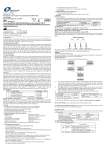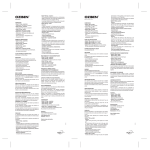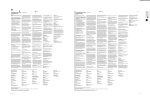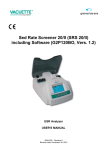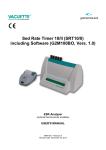Download Summary of Product Characteristics
Transcript
Irish Medicines Board Summary of Product Characteristics 1 NAME OF THE MEDICINAL PRODUCT TISSEEL Lyo Powder and Solvent for Sealant 2 QUALITATIVE AND QUANTITATIVE COMPOSITION Component 1: Sealer Protein Solution (Sealer Protein Concentrate - Lyophilized - reconstituted with Aprotinin Solution) 91 mg1/ml 0.6 - 5 IU/ml 3000 KIU2/ml Human Fibrinogen (as clottable Protein) Human Factor XIII Aprotinin Component 2: Thrombin Solution (Thrombin - Lyophilized - reconstituted with Calcium Chloride Solution) Human Thrombin 500 IU3/ml Calcium Chloride 40 micromoles/ml 1 ml, 2ml and 5 ml Sealer Protein Solution and 1 ml, 2ml and 5 ml Thrombin Solution, respectively, result in 2 ml, 4 ml and 10 ml final product ready for use. After mixing Component 1: Sealer protein solution 1 ml 2 ml 4 ml 10 ml Human Fibrinogen (as clottable protein) Aprotinin Component 2: Thrombin solution 45.5 mg 91 mg 182 mg 455 mg 1,500 KIU 3,000 KIU 6,000 KIU 15,000 KIU Human Thrombin Calcium Chloride 250 IU 20 micromoles 500 IU 40 micromoles 1,000 IU 80 micromoles 2,500 IU 200 micromoles For full list of excipients, see section 6.1. 1 Contained in a total protein concentration of 110.5 mg/ml 1 EPU (European Pharmacopoeia Unit) corresponds to 1800 KIU (Kallidinogenase Inactivator Unit) 3 Thrombin activity is calculated using the current WHO International Standard for Thrombin. 2 ______________________________________________________________________________________________________________________ Date Printed 27/03/2014 CRN 2134788 page number: 1 Irish Medicines Board 3 PHARMACEUTICAL FORM Powder and Solvent for Sealant Freeze-dried constituents are hygroscopic, white or pale yellow powders or friable solids; liquid constituents are clear, colourless solutions. 4 CLINICAL PARTICULARS 4.1 Therapeutic Indications As a coagulant producer for use as a tissue sealant and haemostatic, for surgical incisions, plastic surgical repairs, orthopaedic, traumatic, and dental surgery. 4.2 Posology and method of administration The use of TISSEEL Lyo is restricted to experienced surgeons who have been trained in the use of TISSEEL Lyo. Posology: The amount of TISSEEL Lyo to be applied and the frequency of application should always be oriented towards the underlying clinical needs of the patient. The dose to be applied is governed by variables including, but not limited to, the type of surgical intervention, the size of the area and the mode of intended application, and the number of applications. Application of the product must be individualized by the treating physician. In clinical trials, the individual dosages have typically ranged from 4 to 20 ml. For some procedures (e.g. liver traumata, or the sealing of large burned surfaces), larger volumes may be required. The initial amount of the product to be applied at a chosen anatomic site or target surface area should be sufficient to entirely cover the intended application area. The application can be repeated, if necessary. However, avoid reapplication of TISSEEL Lyo to a pre-existing polymerized TISSEEL Lyo layer as TISSEEL Lyo will not adhere to a polymerized layer. As a guideline for the gluing of surfaces, 1 pack of TISSEEL Lyo 2 ml (i.e., 1 ml Sealer Protein Solution plus 1 ml Thrombin Solution) will be sufficient for an area of at least 10 cm2. When TISSEEL Lyo is applied by spray application the same quantity will be sufficient to coat considerably larger areas, depending on the specific indication and the individual case. Caution must be used when applying fibrin sealant using pressurized gas. The user must follow the instructions and precautions in the device user manual, for example regarding the need to limit the gas pressure in accordance with the instructions, and is cautioned against the spray application of TISSEEL Lyo with devices produced by other manufacturers (see also section 4.4). The only device designed for the application of TISSEEL Lyo in enclosed thoracic and abdominal spaces is the DuploSpray MIS applicator and regulator system. However, all the other instructions and warnings listed in the previous paragraph and in section 4.4 still apply. To avoid the formation of excess granulation tissue and to ensure gradual absorption of the solidified fibrin sealant, as thin a layer as possible of the mixed Sealer Protein - Thrombin Solutions, or of the individual components, should be applied. ______________________________________________________________________________________________________________________ Date Printed 27/03/2014 CRN 2134788 page number: 2 Irish Medicines Board Excessive thickness of the fibrin layer may negatively interfere with the product’s efficacy and the wound healing process. If used for tissue adherence, it is recommended that the initial application cover the entire intended application area. Paediatric population Safety and efficacy of the product in paediatric patients have not been established. Method and route of administration For topical (i.e. epilesional) use only, do not inject. Prepare the solutions as described at 6.6. In order to ensure optimal safe use of TISSEEL Lyo by spray application the following recommendations should be followed: In open wound surgery - a pressure regulator device that delivers a maximum pressure of no more than 2.0 bar (28.5 psi) should be used. In minimally invasive/laparoscopic procedures – a pressure regulator device that delivers a maximum pressure of no more than 1.5 bar (22 psi) and uses carbon dioxide gas only should be used. Prior to applying TISSEEL Lyo the surface area of the wound needs to be dried by standard techniques (e.g. intermittent application of compresses, swabs, use of suction devices). TISSEEL Lyo should only be reconstituted and administered according to the instructions and with the devices recommended for this product (see section 6.6). For spray application, see sections 4.4 and 6.6 for specific recommendations on the required pressure and distance from tissue per surgical procedure and length of applicator tips. Prior to application, TISSEEL Lyo must be warmed to 33-37°C. Tisseel must not be exposed to temperatures above 37°C and must not be microwaved. Separate, sequential application of the two components of TISSEEL Lyo must be avoided. Application beyond the intended area should be avoided. If application is interrupted, clogging occurs immediately in the cannula. Replace the application cannula with a new one only immediately before application is resumed. If the aperture of the joining piece (Y connector) facing the cannula is clogged, use the spare joining piece provided in the package. In cases where very small volumes (1 to 2 drops) of TISSEEL Lyo are administered, expel and discard the first several drops from the application cannula immediately before application, to ensure use of adequatemixed product. (see Section 4.4). The sealer protein and thrombin solutions are denatured by alcohol, iodine, or heavy metal ions. If any of these substances have been used to clean the wound area, the area must be thoroughly rinsed before application of TISSEEL Lyo. Oxidised cellulose-containing preparations may reduce the efficacy of TISSEEL Lyo and should not be used as carrier materials (see section 6.2) After TISSEEL Lyo has been applied, the area should not be disturbed for 3 to 5 minutes to allow the product to polymerize for adherence. Depending on type of use, the sealed parts may have to be fixed or held in the desired position for this time. ______________________________________________________________________________________________________________________ Date Printed 27/03/2014 CRN 2134788 page number: 3 Irish Medicines Board It is strongly recommended that every time TISSEEL Lyo is applied to a patient, the name and batch number of the product are recorded in order to maintain a link between the patient and the batch of the product. 4.3 Contraindications TISSEEL Lyo alone is not indicated for the treatment of massive and brisk arterial or venous bleeding. TISSEEL Lyo must not be applied intravascularly. Intravascular application of TISSEEL Lyo may result in lifethreatening thromboembolic events. TISSEEL Lyo must not be used to replace skin sutures intended to close surgical wounds. Known hypersensitivity to any constituents of the product, including aprotinin (see also section 4.4. Warnings). 4.4 Special warnings and precautions for use Caution must be used when applying fibrin sealant using pressurized air or gas. (See section 4.2 and section 4.8) TISSEEL Lyo alone is not indicated for the treatment of severe or brisk arterial or venous bleeding which is not controlled by conventional surgical techniques. For epilesional use only. Do not apply intravascularly. Soft tissue injection of TISSEEL Lyo carries the risk of local tissue damage. Intravascular application can lead to intravascular coagulation and may result in life-threatening thromboembolic events and might increase the likelihood and severity of acute hypersensitivity reactions in susceptible patients. TISSEEL Lyo must be applied with caution to minimize any risk of intravascular application, for example in coronary bypass surgery. Because of the risk of intravascular injection, the product also must not be injected into highly vascularized tissue, such as nasal mucosa. In surgical applications that require the use of minimal volumes of fibrin sealant (e.g. pterygium surgery) the first few drops should be expelled and discarded before application to ensure adequate mixing of the sealer protein and thrombin solutions. Use of the first few drops in these procedures could result in the product being ineffective. In two retrospective, non-randomized studies in Coronary Artery Bypass Graft (CABG) surgery, patients that received fibrin sealant showed a statistically significant increased risk of mortality. While these studies could not provide a determination of a causal relationship, the increased risk associated with the use of TISSEEL Lyo in these patients cannot be excluded. Therefore, additional care should be taken to avoid inadvertent intravascular administration of this product. Life threatening thromboembolic complications may occur if the preparation is unintentionally applied intravascularly. Injection into the nasal mucosa must be avoided as thromboembolic complications may occur in the ophthalmic arterial region. Any application of pressurized air or gas is associated with a potential risk of air or gas embolism, tissue rupture, or gas entrapment with compression, which may be life-threatening or fatal. Apply TISSEEL Lyo as a thin layer. Excessive clot thickness may negatively interfere with the product’s efficacy and the wound healing process. Life-threatening/fatal air or gas embolism has occurred with the use of spray devices employing a pressure regulator to administer fibrin sealants. This event appears to be related to the use of the spray device at higher than recommended pressures and/or in close proximity to the tissue surface. The risk appears to be higher when fibrin sealants are sprayed with air, as compared to CO2 and therefore cannot be excluded with TISSEEL Lyo when sprayed in open wound surgery. ______________________________________________________________________________________________________________________ Date Printed 27/03/2014 CRN 2134788 page number: 4 Irish Medicines Board When applying TISSEEL Lyo using a spray device, be sure to use a pressure within the pressure range recommended by the spray device manufacturer (see table in section 6.6 for pressures and distances). TISSEEL Lyo spray application should only be used if it is possible to accurately judge the spray distance as recommended by the manufacturer. Do not spray closer than the recommended distances. When spraying TISSEEL Lyo, changes in blood pressure, pulse, oxygen saturation and end tidal CO2 should be monitored because of the possibility of occurrence of air or gas embolism (also see section 4.2). TISSEEL must not be used with the EasySpray/Spray set in enclosed body areas As with any protein-containing product, allergic type hypersensitivity reactions are possible. Signs of hypersensitivity reactions may include hives, generalized urticaria, tightness of the chest, wheezing, hypotension, and anaphylaxis. If these symptoms occur, the administration must be discontinued immediately. Intravascular application might increase the likelihood and severity of acute hypersensitivity reactions in susceptible patients. Manifestations of hypersensitivity reactions to TISSEEL Lyo observed include: bradycardia, tachycardia, hypotension, flushing, bronchospasm, wheezing, dyspnea, nausea, urticaria, angioedema, pruritus, erythema, paresthesia. Fatal anaphylactic reactions, including anaphylactic shock, have also been reported with TISSEEL Lyo (see section 4.8). At the first sign or symptom of a hypersensitivity reaction, TISSEEL Lyo application must be stopped and medical care initiated. Remaining product must be removed from the site of application. TISSEEL Lyo contains bovine protein (aprotinin), a polypeptide known to be associated with anaphylactic reactions. Even in case of strict local application, there is a risk of anaphylactic reaction linked to the presence of bovine aprotinin. The risk seems to be higher in cases where there was previous exposure, even if it was well tolerated. Therefore any use of aprotinin or aprotinin containing products should be recorded in the patients’ records. If fibrin sealants are applied in confined spaces, e.g. the brain or the spinal cord, the risk of compressive complication should be taken into account. In the event of anaphylactic or severe hypersensitivity reactions, administration is to be discontinued and state-of-theart emergency measures are to be taken. In case of shock, standard medical treatment for shock should be implemented. Sealer Protein Concentrate and Thrombin are made from human plasma. The risk of transmitting an infectious agent has been reduced by screening plasma donors for prior exposure to certain viruses, by testing for the presence of certain current viral infections, and by inactivating and/or removing viruses. Despite this, when medicinal products prepared from human blood or plasma are administered, the possibility of transmitting infective agents cannot be totally excluded. This also applies to unknown or emerging viruses or other pathogens. The measures taken are considered effective for enveloped viruses such as HIV, HBV, and HCV, and for the nonenveloped virus HAV. The measures taken may be of limited value against small non-enveloped viruses such as parvovirus B19. Parvovirus B19 infection may be serious for pregnant women (fetal infection) and for individuals with immunodeficiency or increased red blood cell turnover (e.g., hemolytic anemia). It is strongly recommended that every time a patient receives a dose of TISSEEL Lyo, the name and batch number of the product are recorded in order to maintain a record of the batches used. Oxidized cellulose-containing preparations should not be used with TISSEEL Lyo (See section 6.2 Incompatibilities). Safety and effectiveness of the product in pediatric patients has not been established. as limited clinical study data are available. ______________________________________________________________________________________________________________________ Date Printed 27/03/2014 CRN 2134788 page number: 5 Irish Medicines Board 4.5 Interaction with other medicinal products and other forms of interaction No formal interaction studies have been performed. Similar to comparable products or thrombin solutions, the product may be denatured after exposure to solutions containing alcohol, iodine or heavy metals (e.g. antiseptic solutions). Such substances should be removed to the greatest possible extent before applying the product. 4.6 Fertility, pregnancy and lactation There are no adequate data from the use of TISSEEL Lyo in pregnant or lactating women. Physicians should carefully consider the potential risks and benefits for each specific patient before prescribing TISSEEL Lyo See section 4.4 for information on Parvovirus B19 infection. The effects of TISSEEL Lyo on fertility have not been established. 4.7 Effects on ability to drive and use machines Not relevant. 4.8 Undesirable effects Hypersensitivity or allergic reactions (which may include but are not limited to angioedema, burning and stinging at the application site, bradycardia, bronchospasm, chills, dyspnea, flushing, generalized urticaria, headache, hives, hypotension, lethargy, nausea, pruritus, restlessness, tachycardia, tightness of the chest, tingling, vomiting, wheezing) may occur in rare cases in patients treated with fibrin sealants/hemostatics. In isolated cases, these reactions have progressed to severe anaphylaxis. Such reactions may especially be seen if the preparation is applied repeatedly, or administered to patients known to be hypersensitive to aprotinin (see section 4.4) or any other constituents of the product. Even if a second treatment with TISSEEL Lyo was well tolerated, a subsequent administration of TISSEEL Lyo or systemic administration of aprotinin may result in severe anaphylactic reactions. Antibodies against components of fibrin sealant/ hemostatic may rarely occur. VASCULAR DISORDERS: Embolism arterial, including cerebral artery embolism, cerebral infarction* SKIN AND SUBCUTANEOUS TISSUE DISORDERS: Impaired healing * as a result of intravascular application into the superior petrosal sinus For safety with respect to transmissible agents, see section 4.4. The adverse reactions presented in this section were reported from clinical trials investigating the safety and efficacy of TISSEEL and from post-marketing experience with Baxter Fibrin Sealants. In these trials,TISSEEL was administered for adjunct hemostasis in cardiac, vascular, and total hip replacement surgeries and in liver and spleen surgeries. Other clinical trials included the sealing of lymphatic vessels in patients undergoing axillary lymph node dissection, sealing of colonic anastomosis and in durasealing in the posterior fossa. In these studies, a total of 1146 patients were administered Baxter Fibrin Sealant. ______________________________________________________________________________________________________________________ Date Printed 27/03/2014 CRN 2134788 page number: 6 Irish Medicines Board Very common ( 1/10) Common ( 1/100 to <1/10) Uncommon ( 1/1,000 to <1/100) Rare ( 1/10,000 to <1/1,000) Very rare (< 1/10,000) Not known (cannot be estimated from the available data) System organ class Preferred MedDRA Term (SOC) Infections and Postoperative wound infection infestations Blood and lymphatic system disorders Fibrin degradation products increased Immune system Hypersensitivity reactions* disorders Anaphylactic reactions* Anaphylactic shock* Paresthesia Bronchospasm Wheezing Pruritus Erythema Nervous system Sensory disturbance disorders Cardiac disorders Bradycardia Tachycardia Vascular disorders Axillary vein thrombosis ** Hypotension Haematoma (NOS) Embolism arterial Cerebral artery embolism Cerebral infarction** Respiratory, thoracic Dyspnoea and mediastinal disorders Gastrointestinal Nausea disorders Intestinal obstruction Skin and subcutaneous Rash tissue disorders Urticaria Impaired healing Musculoskeletal and Pain in an extremity connective tissue disorders General disorders and Procedural pain administration site conditions Pain Increased body temperature Flushing Oedema Frequency Common Uncommon Not known Not known Not known Not known Not known Not known Not known Not known Common Not known Not known Common Rare Not known Not known Not known Not known Not known Uncommon Not known Common Not known Not known Common Uncommon Common Common Not known Not known ______________________________________________________________________________________________________________________ Date Printed 27/03/2014 CRN 2134788 page number: 7 Irish Medicines Board Injury, poisoning and procedural complications Seroma Angioedema * anaphylactic reactions and anaphylactic shock have included fatal outcomes. ** as a result of intravascular application into the superior petrosal sinus. Very common Not known Class Reactions Other adverse reactions associated with the fibrin sealant/hemostatic class include: Air or gas embolism when using devices with pressurized air or gas; this event appears to be related to the use of the spray device at higher than recommended pressures and in close proximity to the tissue surface. Manifestations of hypersensitivity include application site irritation, chest discomfort, chills, headache, lethargy, restlessness, and vomiting. Reporting of suspected adverse reactions Reporting suspected adverse reactions after authorisation of the medicinal product is important. It allows continued monitoring of the benefit/risk balance of the medicinal product. Healthcare professionals are asked to report any suspected adverse reactions via: - IMB Pharmacovigilance, Earlsfort Terrace, IRL - Dublin 2; Tel: +353 1 6764971; Fax: +353 1 6762517; Website: http://www.imb.ie/; e-mail: [email protected] 4.9 Overdose No case of overdose has been reported. 5 PHARMACOLOGICAL PROPERTIES 5.1 Pharmacodynamic properties Pharmacotherapeutic group: local hemostatics, ATC code: B02BC; tissue adhesives, ATC code: V03A K The fibrin adhesion system imitates the last phase of physiological blood coagulation. Conversion of fibrinogen into fibrin occurs by the splitting of fibrinogen into fibrin monomers and fibrinopeptides. The fibrin monomers aggregate and form a fibrin clot. Factor XIIIa, which is generated from Factor XIII by the concerted action of thrombin and calcium ions, stabilizes the clot by the cross-linking of fibrin fibres. As wound healing progresses, increased fibrinolytic activity is induced by plasmin, and decomposition of fibrin to fibrin degradation products is initiated. Proteolytic degradation of fibrin is inhibited by anti-fibrinolytics. Aprotinin is present in TISSEEL Lyo as an antifibrinolytic to prevent premature degradation of the clot. Fibrin Sealant VH S/D (frozen presentation) was evaluated in a prospective, parallel design, randomized (1:1), doubleblind, multicenter clinical study against a previous single virus inactivated formulation of the product, TISSEEL Kit VH (lyophilized presentation), in 317 subjects undergoing cardiac surgery requiring cardiopulmonary bypass (CPB) and median sternotomy. Patients were treated with Fibrin Sealant VH S/D or the control product only when hemostasis was not achieved by conventional surgical methods. For the endpoint, hemostasis achieved at the primary treatment site within 5 minutes of treatment and maintained until closure of the surgical wound, Fibrin Sealant VH S/D was noninferior to the earlier formulation of the product using a one-sided 97.5% confidence interval on the difference in the proportion of subjects successfully treated. Hemostasis within 5 minutes and maintained until surgical closure FIBRIN SEALANT VH S/D FIBRIN SEALANT VH Intent to Treat Analysis 127/144 (88.2%) 129/144 (89.6%) Per Protocol Analysis 108/123 (87.8%) 122/135 (90.4%) No difference to control groups not receiving Fibrin Sealant VH S/D (frozen presentation) was observed in an exploratory study in hip joint replacement for postoperative blood loss and in a study in axillary lymph node dissection for duration of axillary drainage. ______________________________________________________________________________________________________________________ Date Printed 27/03/2014 CRN 2134788 page number: 8 Irish Medicines Board 5.2 Pharmacokinetic properties Intravascular administration is contraindicated. As a consequence, intravascular pharmacokinetic studies were not performed in man. Fibrin sealants/hemostatics are metabolized in the same way as endogenous fibrin by fibrinolysis and phagocytosis. 5.3 Preclinical safety data For efficacy, in vivo studies in four animal models closely imitating the situation in patients were used. Fibrin Sealant VH S/D demonstrated efficacy regarding primary, secondary and sustained hemostasis and sealing. Due to its nature as well as its method of application and mechanism of action (usually single, only in exceptional cases repeated application of small volumes; local efficacy without systemic exposure or distribution to other organs and tissues), no preclinical safety data are available for Fibrin Sealant VH S/D on subacute and chronic toxicity, carcinogenicity, reproductive and developmental toxicity or immune stimulation. Single-dose toxicity studies in rats and rabbits indicated no acute toxicity of Fibrin Sealant VH S/D (frozen presentation). Furthermore, no evidence for mutagenicity could be seen in appropriate in vitro tests. Fibrin Sealant VH S/D (frozen presentation) proved well tolerated in wound healing models in rats and rabbits. The Sealer Protein Solutions of Fibrin Sealant VH S/D (frozen and lyophilized presentations) were also well tolerated by in vitro human fibroblast cultures demonstrating excellent cellular compatibility and non-cytotoxicity. Based on a detailed literature review, any negative influence or toxicity of the residual solvent/detergent reagents (see 6.1) on Fibrin Sealant VH S/D can be essentially excluded. 6 PHARMACEUTICAL PARTICULARS 6.1 List of excipients Component 1: Sealer Protein Solution Human Albumin Solution Histidine Nicotinic Acid Polysorbate 80 (Tween 80) Sodium Citrate Water for Injections Component 2: Thrombin Solution Human Albumin Solution Sodium Chloride Water for Injections 6.2 Incompatibilities This medicinal product must not be mixed with medicinal products other than appropriate solvents mentioned in 6.6. 6.3 Shelf life 2 years. 6.4 Special precautions for storage Keep out of the reach and sight of children. Store TISSEEL Lyo below +25°C. Do not freeze. Keep TISSEEL Lyo in the outer carton to protect from light. Use the reconstituted sterile solutions within 4 hours of preparation. Keep the reconstituted sterile solutions at 37ºC or at room temperature (up to +25ºC) without stirring if not used immediately. ______________________________________________________________________________________________________________________ Date Printed 27/03/2014 CRN 2134788 page number: 9 Irish Medicines Board Reconstituted solutions must not be refrigerated or frozen. 6.5 Nature and contents of container All components of TISSEEL Lyo are filled into glass containers (Sealer Protein Concentrate Lyophilized,: type I glass (1 ml + 2 ml) and type II glass (5ml), all other vials: type I glass) conforming to Ph. Eur. requirements. The vial containing Sealer Protein Concentrate - Lyophilized is equipped with a magnetic stirrer. TISSEEL Lyo is available in the following pack sizes: 1 x 2 ml (1 ml + 1 ml), 1 x 4 ml (2 ml + 2 ml) and 1 x 10 ml (5 ml + 5 ml). The Kit for Reconstitution and Application (DUPLOJECT System) is for single use only. Do not resterilize! Not all pack sizes may be marketed. Other accessories for application of the product can be obtained from BAXTER. 6.6 Special precautions for disposal of a used medicinal product or waste materials derived from such medicinal product and other handling of the product General Before administration of TISSEEL Lyo care has to be taken that parts of the body outside the desired application area are sufficiently covered to prevent tissue adhesion at undesired sites. To prevent TISSEEL Lyo from adhering to gloves and instruments, wet these with sodium chloride solution before contact. Preparation and reconstitution Prior to reconstitution of the fibrin sealant components the rubber stoppers of all vials should be cleansed. Direct contact between disinfectant and product must be avoided (see section 4.5). I. Preparation of Component 1 - Sealer Protein Solution The Sealer Protein Concentrate – Lyophilized is dissolved with the Aprotinin Solution to form the Sealer Protein Solution. Sealer Protein Concentrate – Lyophilized is reconstituted using the FIBRINOTHERM warming and stirring device (recommended method). Alternatively, a sterile water bath at a temperature of 33 - 37°C can be used. Reconstitution using the FIBRINOTHERM device: The FIBRINOTHERM device maintains a constant temperature of 37°C. It also shortens the dissolution time of the Sealer Protein Concentrate – Lyophilized by rotating the magnetic stirrer contained in each Sealer Protein Concentrate – Lyophilized vial. Place the vials containing Sealer Protein Concentrate – Lyophilized and Aprotinin Solution into the appropriate openings of the preheated FIBRINOTHERM device and heat the vials for approximately 3 minutes. Transfer the Aprotinin Solution into the vial containing the Sealer Protein Concentrate – Lyophilized using one needle and the blue-scaled syringe provided in the single-sterile kit for reconstitution. Place the Sealer Protein vial into the stirring well of the FIBRINOTHERM device (use the adaptor, if necessary) and stir until complete dissolution. Reconstitution is complete as soon as no particles are visible anymore when holding the vial against the light. If particles are present, keep on stirring the solution at 37°C for a few more minutes until complete dissolution. Turn off the magnetic stirrer when dissolution is complete. Note: Excessive stirring might compromise product quality! ______________________________________________________________________________________________________________________ Date Printed 27/03/2014 CRN 2134788 page number: 10 Irish Medicines Board Keep the Sealer Protein Solution at 37°C or at room temperature (up to 25ºC) without stirring if it is not used immediately. Before use the solution should be warmed to 37°C. To ensure homogeneity stir or swirl briefly before drawing up the Sealer Protein Solution into the blue-scaled syringe provided in the double-sterile kit for application. Withdraw the reconstituted Sealer Protein Solution from the vial under sterile conditions. For further instructions please refer to the instructions for use of the FIBRINOTHERM device. Reconstitution using a water bath: Preheat the vials containing the Sealer Protein Concentrate – Lyophilized and the Aprotinin Solution for approximately 3 minutes in a water bath at a temperature of 33 - 37°C. (Heating beyond 37°C must be avoided!) Transfer the Aprotinin Solution into the vial containing the Sealer Protein Concentrate – Lyophilized using one needle and the blue-scaled syringe provided in the single-sterile kit for reconstitution. Return the Sealer Protein vial to the water bath at 33 - 37°C for one minute. Swirl briefly but avoid excessive frothing. Then return the vial to the water bath and check periodically for complete dissolution. Reconstitution is complete as soon as no particles are visible when holding the vial against the light. If particles are present, keep the vial at 33 - 37°C for a few more minutes and agitate the solution until complete dissolution. Keep the Sealer Protein Solution at 33 - 37°C or at room temperature (up to 25ºC) if not used immediately. Before use the solution should be warmed to 33 - 37°C. To ensure homogeneity swirl briefly before drawing up the Sealer Protein Solution into the blue-scaled syringe provided in the double-sterile kit for application. Withdraw the reconstituted Sealer Protein Solution from the vial under sterile conditions. Note: When using a water bath for reconstitution instead of the FIBRINOTHERM device, special precautions must be taken against submersing the vial, particularly the septum, to avoid possible contamination. II. Preparation of Component 2 - Thrombin Solution The Thrombin – Lyophilized is dissolved with the Calcium Chloride Solution to form the Thrombin Solution. Transfer the contents of the Calcium Chloride Solution vial into the Thrombin – Lyophilized vial. Use the second needle and the black-scaled syringe provided in the single-sterile kit for reconstitution. Swirl briefly to dissolve the lyophilized material. To warm the Thrombin Solution either the FIBRINOTHERM device or a water bath can be used. Keep the Thrombin Solution at 33 - 37°C or at room temperature (up to 25ºC) if not used immediately. Before use, the solution should be warmed to 33 - 37°C. Prior to use, draw up the Thrombin Solution from the vial using the second needle and the black-scaled syringe provided in the double-sterile kit for application. Note: Syringes and needles used for the reconstitution of one component must not be re-used for the reconstitution of the other component, as this would lead to solidification of that component in the vial or syringe. III. Use of reconstituted TISSEEL Lyo Components Both fibrin sealant components must be used within 4 hours after reconstitution. Reconstituted solutions must not be refrigerated or frozen. ______________________________________________________________________________________________________________________ Date Printed 27/03/2014 CRN 2134788 page number: 11 Irish Medicines Board Administration The Sealer Protein and the Thrombin Solutions should be clear or slightly opalescent. Do not use solutions that are cloudy or have deposits. Reconstituted products should be inspected visually for particulate matter and discoloration prior to administration. For application, the two single-use syringes with the reconstituted Sealer Protein Solution and Thrombin Solution should be clipped into the DUPLOJECT Two-Syringe Clip and this assembly should be connected to a joining piece and an application cannula. All necessary devices are provided in the double-sterile kit for application. The common plunger of the DUPLOJECT Two-Syringe Clip ensures that equal volumes are fed through the joining piece before being mixed in the application cannula and ejected. Operating Instructions Place the two syringes filled with Sealer Protein Solution and with Thrombin Solution into the clip. Both syringes should be filled with equal volumes. Connect the nozzles of the two syringes to the joining piece ensuring that they are firmly fixed. Secure the joining piece by fastening the tether strap to the DUPLOJECT Two-Syringe Clip. Should the pull strap tear, use the spare joining piece. If none is available, further use is still possible but tightness of the connection needs to be ensured to prevent any risk of leaking. Fit an application cannula onto the joining piece. Do not expel the air remaining inside the joining piece or application cannula until you start actual application as the aperture of the cannula may clog otherwise. Apply the mixed Sealer Protein - Thrombin Solution onto the recipient surface or surfaces of the parts to be sealed. If application of the fibrin sealant components is interrupted, clogging occurs immediately in the cannula. Replace the application cannula with a new one only immediately before application is resumed. If the apertures of the joining piece are clogged, use the spare joining piece provided in the package. ______________________________________________________________________________________________________________________ Date Printed 27/03/2014 CRN 2134788 page number: 12 Irish Medicines Board Note: After blending of the sealant components, the fibrin sealant starts to set within seconds on account of the high Thrombin concentration (500 IU/ml). Application is also possible with other accessories supplied by BAXTER that are particularly suited for, e.g. endoscopic use, minimally invasive surgery, application to large or difficult-to-access areas. When using these application devices, strictly follow the Instructions for Use of the devices. After the two components have been applied, approximate the wound areas. Fix or hold the glued parts with continuous gentle pressure in the desired position for about 3–5 minutes to ensure that the setting fibrin sealant adheres firmly to the surrounding tissue. In certain applications, biocompatible material, such as collagen fleece, is used as a carrier substance or for reinforcement. Spray application When applying TISSEEL Lyo using a spray device be sure to use a pressure and a distance from tissue within the ranges recommended by the manufacturer as follows: Recommended pressure, distance and devices for spray application of TISSEEL Lyo Pressure Recommended Spray set Applicator Recommended Surgery regulator to distance from to be used tips to be used spray pressure be used target tissue Tisseel / Artiss n.a. EasySpray Spray Set 1.5-2.0 bar Open wound Tisseel / 10-15cm (21.5-28.5 psi). Artiss n.a. EasySpray Spray Set 10 pack Duplospray MIS Applicator 20cm Laparoscopic/ minimally invasive procedures n.a. Duplospray MIS Applicator 30cm Duplospray MIS Applicator 40cm Duplospray MIS Regulator Duplospray MIS Regulator NIST B11 Duplospray MIS Regulator Duplospray MIS Regulator NIST B11 Duplospray MIS Regulator Duplospray MIS Regulator NIST B11 2 – 5 cm 1.2-1.5 bar (18-22 psi) Duplospray MIS ______________________________________________________________________________________________________________________ Date Printed 27/03/2014 CRN 2134788 page number: 13 Irish Medicines Board Replaceable tip Regulator Duplospray MIS Regulator NIST B11 When spraying the TISSEEL Lyo, changes in blood pressure, pulse, oxygen saturation and end tidal CO2 should be monitored because of the possibility of occurrence of air or gas embolism (see sections 4.2 and 4.4). Disposal Any unused product or waste material should be disposed of in accordance with local requirements. 7 MARKETING AUTHORISATION HOLDER Baxter Healthcare, Caxton Way, Thetford, Norfolk, IP24 3SE. UK 8 MARKETING AUTHORISATION NUMBER PA 167/129/6 9 DATE OF FIRST AUTHORISATION/RENEWAL OF THE AUTHORISATION Date of first authorisation: 21st January 2011 10 DATE OF REVISION OF THE TEXT March 2014 ______________________________________________________________________________________________________________________ Date Printed 27/03/2014 CRN 2134788 page number: 14















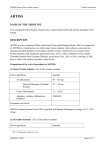
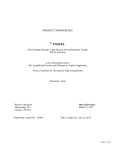

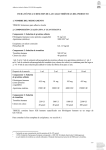
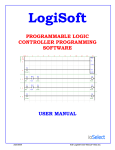
![[Product Monograph Template - Schedule D]](http://vs1.manualzilla.com/store/data/005793815_1-9ff4321a86e1483b72bfcf39a23d58ab-150x150.png)

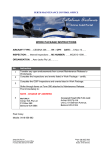

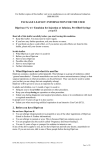
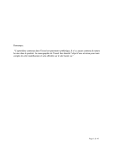
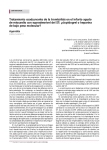
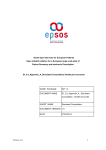
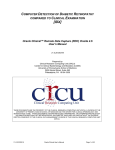
![TEMPLATE No1 [CPMP positive opinion full application]](http://vs1.manualzilla.com/store/data/005681628_1-1a3acb54fcca990dd8c826546eb4788f-150x150.png)
